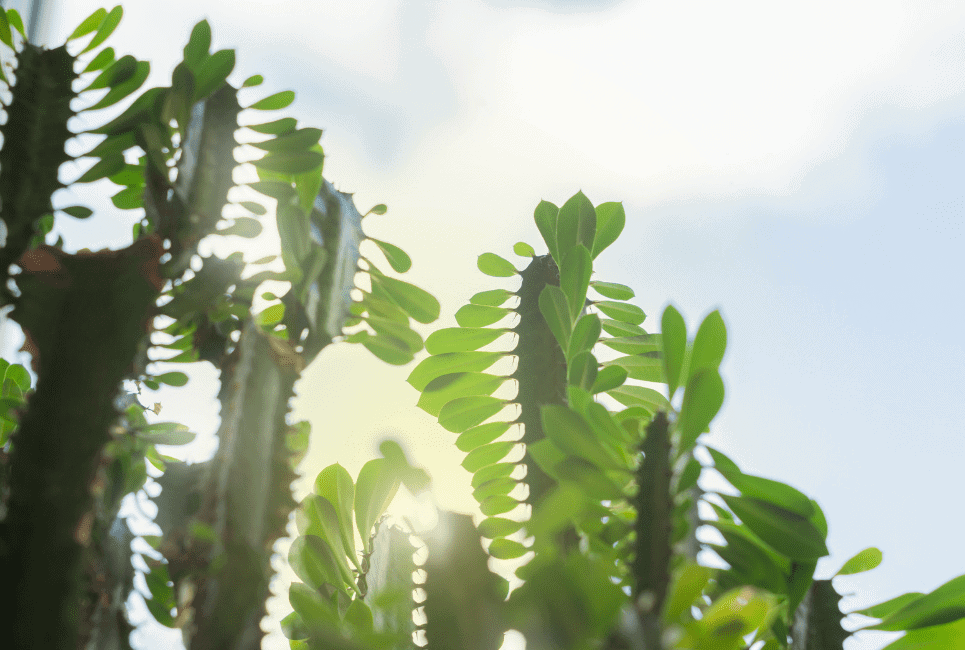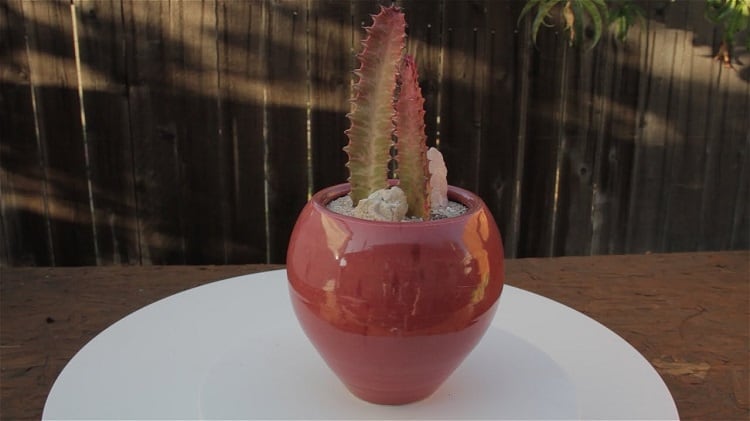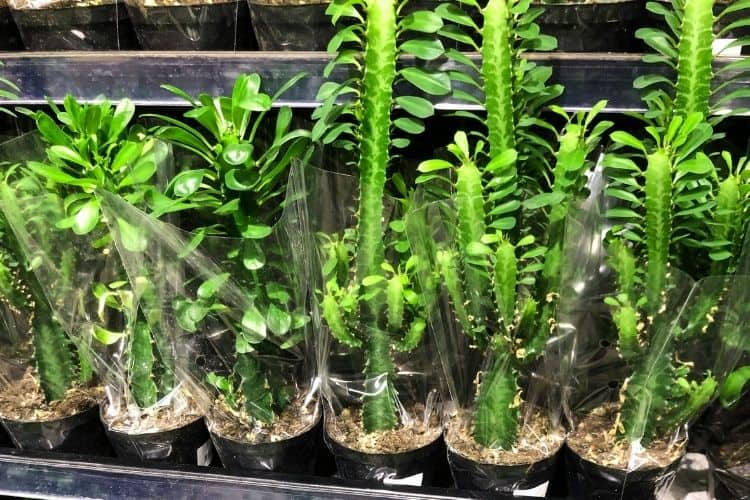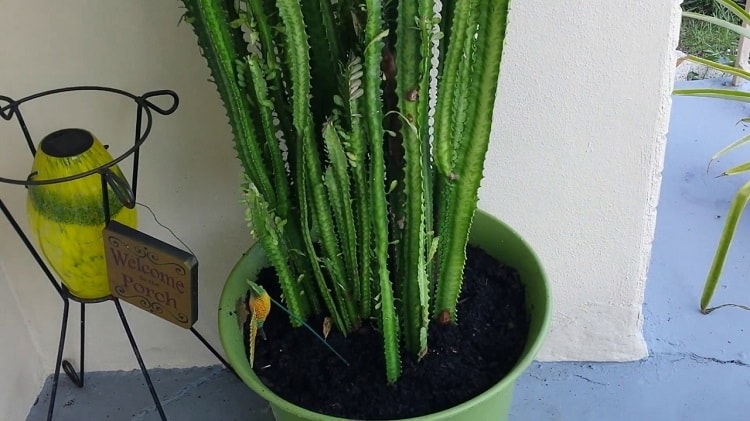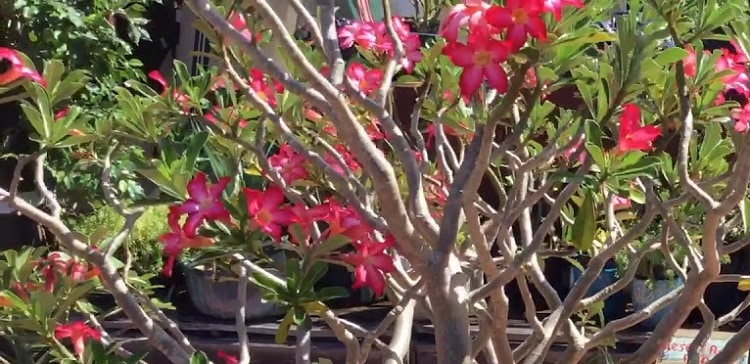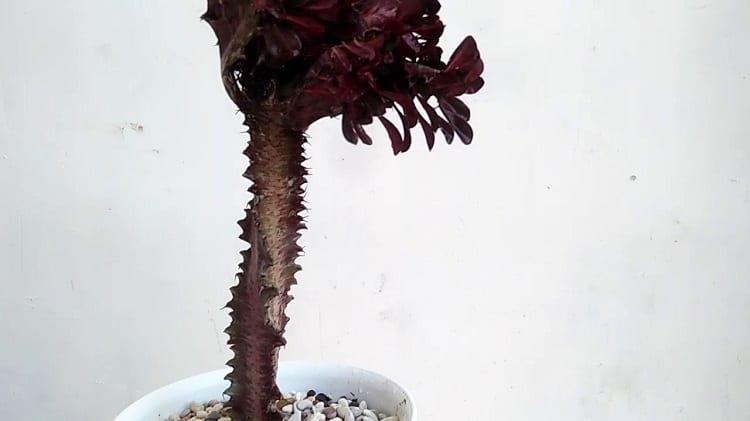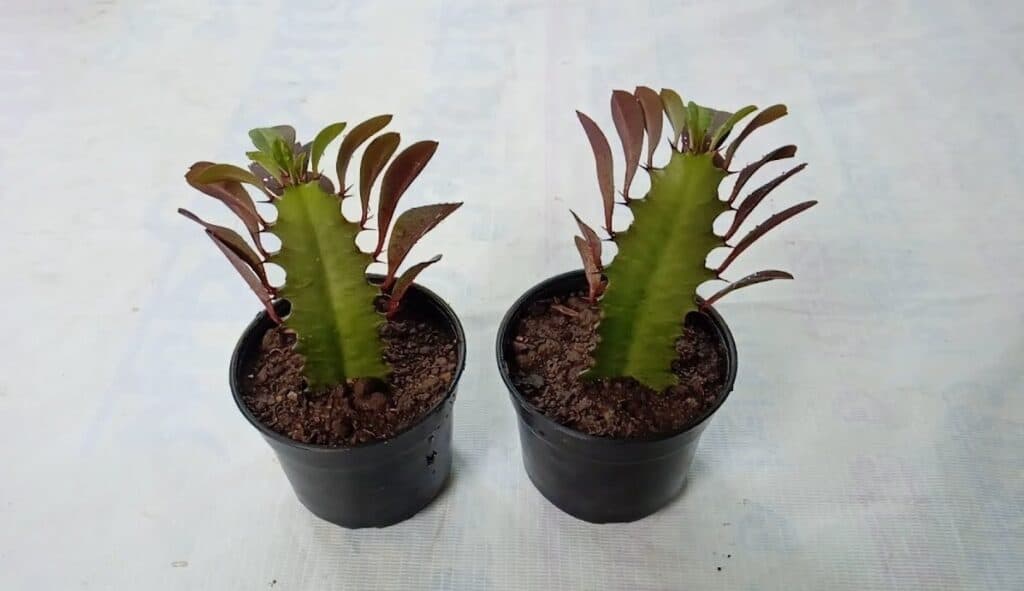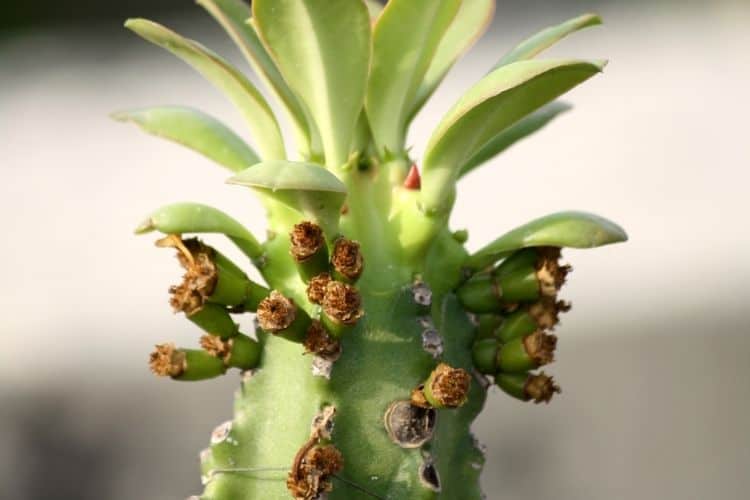- Apricot Tree: Can You Really Grow It On Your Own? - November 29, 2021
- Lavender Tree: How Soon Your Can Expect Your Tree To Grow? - November 2, 2021
- Bottle Brush Tree: Can You Grow It In Your Own Yard? - November 2, 2021
Are you ready to make an intriguing festive statement this season with a blend of a pot combo and gorgeous plant? Well, a succulent shrub that boasts milky latex would be a perfect option! But, of course, we are talking about the African milk tree (Euphorbia trigona)!
The African milk tree is native to Southern and Central Africa, a succulent variety with overhanging, deep maroon color leaves and deep green, thick stems lined with tiny spikes. This succulent thrives in thorny, dense thickets. Many growers claim that the plant grows happy and healthy in the apartment throughout the world and has adapted significantly to indoor spaces.
While a succulent, the African milk tree resembles a cactus. It is typically like a fusion of euphorbias and cacti, making people refer to it as cactus without realizing the difference. They can mistake the African milk tree since both euphorbias and cacti are similar in various characteristics that the confusion tends to be explicable.
The two have many species of different shapes, are spiny, and store moisture in swollen stems. When grown outdoors, the African milk may bloom and produce small yellow or white flowers. Growers appreciate the distinctive features of the trigona from its leaves that grow by the edges of the upright stems.
How to Identify African Milk Tree
- Botanical Name: Euphorbia trigona
- Common Names: Friendship cactus, cathedral cactus, Abyssinian Euphorbia, candelabra cactus, African milk tree cactus
- Origin & Family: West Africa – Euphorbaceae
- Growability: Simple with a gradual growth rate
- Size: 2-inches to 4-inches feet tall for indoor planting and 7-inches to 9-inches feet tall for outdoor planting
- Light: Protection for direct sun can burn the plant as it prefers bright light
- Temperature: 35 degrees to 90 degrees Fahrenheit
- Water: Avoid overwatering and keep the soil slightly moist
- Fertilizer: Use water-soluble, balanced fertilizer during summer and spring and fertilize monthly
- Soil: Well-draining succulent soil
- Pests & Diseases: Root rot, plant scale, mealybug
- Propagation: Stem cuttings
- Toxicity: A poisonous and skin irritant sap. As such, handling entails protecting the mouth and eyes. Skin contact requires immediate washing and ensuring children and pets are not close to the plant.
African milk tree boasts various gardening and landscaping uses when in its natural habitat. Many US growers grow it as an indoor plant. They also use the plant as a gorgeous accumulation to succulent and cactus gardens in warmer regions. While they have some leaves, experts consider the African milk tree succulent plants.
The plant has short-lived and small leaves, growing along the ridges that make up the sides of its rectangular stems. You can even notice thorns emerging from these ridges.
The African milk tree’s thorns grow in two sets, with single leaves emerging from between these sets. As a result, you can have slight yellow or white flowers when planted outdoors, and they may not bloom when grown indoors.
Where Does African Milk Tree Grow
The African milk tree grows well in bright but indirect sunlight, and when grown indoors, a southern-facing window will be perfect. Outside space with the partial sun will also work well. When the summer is not too hot, your plant can have full sun. You can also offset an excessive amount of bright sunlight with extra watering.
As a drought-tolerant plant, the African milk tree can withstand an arid climate, and relatively hot temperatures are suitable. However, the plant may not thrive well in the cold, and temperatures below 10 degrees can stop it from flourishing.
In essence, you will need to put your African milk tree in a space with partial shade or indirect sunlight when you plan to grow it in a place with hot summers. With that, you can avoid overheating. Growing your African milk tree in an area with excessive humidity can cause pests or fungus, and it does not need any extra moisture.
Ensure to put your euphorbia trigona indoors during winters, and when you have below five degrees temperatures, it can be quite fatal for the plant. Therefore, ensure to keep your African milk tree in a cool place and water it rarely to leave the soil nearly dry during the cold winter months.
We recommend correlating low temperatures with infrequent watering. Otherwise, your African milk tree will not wither or become dormant.
Uses of African Milk Tree
The African milk tree can reach a height of between 12 and 20 feet, and people use the plant for many purposes, including medicinal uses, cattle forage, and hedging. In addition, people also convert the milk-like fluid this African shrub produces into fuel like gasoline. Semi-arid gardeners also grow the plant as indoor or houseplant plants as part of their landscaping.
The appearance of any typical African milk tree is like that of a spineless cactus. The tree branches produce deciduous, small leaves and flourish in a bogus whorl shape.
The African milk tree serves as a common source of cattle feed all over India, and people also use the plant as natural fencing or hedging. Mosquito repellent and firewood are other uses of the African milk tree in Africa and Brazil.
Many growers were interested in growing the African milk tree as a possible fuel source as of 2010. This is because they can convert the sap into a substance similar to gasoline. People also grow the plant on the lands not used for crops, and you can compare yields from an acre of the African shrub to that of other biodiesel sources.
Places like India, Brazil, and other regions in Asia have traditional medicine practices that rely on the African milk tree to treat various ailments.
For example, people use the African milk bush to treat ear pain, asthma, and warts. In addition, other diseases like neuralgia and rheumatism rely on this plant for treatment. Experts have also studied it as a potential cancer treatment.
How to Grow African Milk Tree from Seed
The African milk tree is a slow grower. Therefore, we won’t recommend this propagating method if you intend to grow it from seed. However, it is as easy as planting the African milk tree seeds in a well-draining soil mixture to propagate from the seeds. You can use this method outdoors, and we recommend growing indoors if you are in a cooler region.
African Milk Tree Growing Conditions
The African milk tree requires fertilizer during its growing season. Ensure to feed the plant with a water-soluble fertilizer once a month during summer and spring. Also, ensure to watch out for disease and pests.
One of the typical issues for African milk trees is mealybugs. Therefore, use a strong spray of water to water them off or a cloth dipped in diluted dish soap if you notice these pests.
In essence, it is critical to water African milk trees sparingly. We recommend watering your plant when you notice the soil top layer drying out or once a week when these drought-tolerant plants are established. You may need to deal with root rot when you overwater.
Give African milk trees ample air circulation and sunlight. When there is too intense bright light, the plant can scorch. Therefore, it is highly recommended to put it in a place that receives a blend of partial shade and full sunlight throughout the day. Ample air circulation and light will help prevent root rot.
Use well-draining soil, and you can allow for better water drainage with a potting mix formulated or sandy soil for cacti. You can also improve the soil’s ability to drain water by adding perlite or pumice to the potting soil.
Plant your African milk tree using clay or terracotta pot. A porous clay pot that has not been glazed can help minimize overwatering risks and absorb extra water.
When to Plant African Milk Tree
Essentially, African milk trees can thrive well outdoors when they get plenty of direct sun if you live in warm climates. Since they can get huge, we recommend giving it enough room to grow. You can also move your plant back outside during summer and bring it inside for the cold months. However, ensure to expose your plant to direct sun slowly in the spring to prevent sunburn.
You must prepare yourself for success when growing your African milk tree. Therefore, where to grow the plant is quite essential. A perennial succulent, the African milk tree has grown for several years in a warm, dry climate that does not drop below freezing point.
Therefore, you will need to leave your African milk tree outside in the garden year-round if you are in a place with below-freezing temperatures.
How to Plant African Milk Tree
The African milk tree is a houseplant that can typically grow between two to four feet tall. However, it can reach up to eight feet high if left to grow outside. Typically, the plant’s stem is a dark green color, and it is covered in five millimeters long small thorns.
The African milk tree is quite popular since it stays green and lush throughout its whole growing season. Also, new growth comes in as a light green color.
It is essential not to overwater your African milk tree since it can be hard to resist pampering your favorite houseplant. Furthermore, while overwatering your plant can be pretty fatal, your African milk tree may not recover from it. Therefore, avoid this problem by maintaining a dry environment and watering infrequently.
Essentially, we recommend not getting the top too heavy since the African milk tree has a shallow root system. Therefore, when you have an unstable or heavy top, it can easily uproot the plant. Also, ensure to wear protective gear when handling or pruning the succulent.
African Milk Tree Water Requirements
Many growers mistake the African milk tree for a cactus, which is why they fail to grow the plant. New growers might think the plant barely requires any water and needs as much sun as possible. That is a big mistake!
The African milk tree is a thirsty plant, even though many experts consider it a drought-tolerant plant. The plant can use plenty of water and dries out quickly in warm temperatures. You may need to consider waiting for the top inch to dry entirely before watering your plant again.
The combination is to have your plant in a warm room and bright light. First, however, water your African milk tree once or twice a week throughout summer or late spring—water at least once a week during winter.
You will notice the stem is a bit soft to the touch when your plant is dehydrated. The stem will then feel puffy and full about five hours after watering the plant. We recommend waiting some more days to be safe if you doubt whether the plant needs a top-up or not.
African Milk Tree Sun Requirements
Before we continue, we need to be careful of plenty of conflicting information online. Many people believe in putting your African milk tree outdoors to receive direct sunlight all day long for light requirements. Other experts contest this assumption as they believe doing so can burn and even damage your plant. They claim that the African milk tree can tolerate a little sun.
Here is what we will recommend.
These are not true cacti as they are succulent. Therefore, the African milk tree may not enjoy or want intense pounding sun. However, since they originated from Central Africa, the African milk tree adapts to the sun and heat. As such, an hour or two of sunlight or bright light all day is tolerable for the plant.
If your location has some partial shade, you can bring your African milk tree outdoors. However, we recommend not to move the plant into intense sunlight suddenly if you have been putting it in a darker place for some time. Doing that can result in scorching risks. Instead, move the plant into the sun for about one hour a day to get them acclimatized for a week. Then, move it back into shade again as you slowly increase the time they use in the sun.
Lower-light settings do not work well with the African milk tree. The plant requires good light levels. You can use a grow light if you can’t give them good light levels. You will have little to no new growth if you provide your plant with low light.
Your plant will have stems bending towards light sources instead of straight upwards and fresh leaves growing on one side of the plant.
Best African Milk Tree Fertilizer
The African milk tree is not overly hungry. However, the plant will appreciate it when it gets a well-balanced fertilizer every few months during its active growth. You can use fertilizers designed for cacti or succulents or use a standard houseplant feed.
You can also use a tempered liquid fertilizer to feed your plant once a month during the summer or spring in the growing season. An organic worm fertilizer is also suitable, and you must ensure to use half the recommended amount of succulent fertilizer. We recommend not fertilizing for a few weeks after repotting or during the winter dormancy period.
Best African Milk Tree Companion Plantings
Desert Rose
Many growers typically use desert rose (Adenium obesum) as a bonsai plant because of its deep pink trumpeting, luscious flowers, delicate and thin leaves, and thick succulent trunk.
The plant is a slow-growing plant, and when it grows, it can reach around 12 inches per year. Desert rose obtains various flower colors that will pair well when planted with your African milk tree. However, the plant can die if exposed to freezing or frost temperatures. It also has toxic sap like the African milk tree.
Jade Plant
Jade plant (Crasssula ovata) can live for a long time with adequate care as a succulent houseplant. Jade plant is relatively easy and resilient to grow indoors. The plant has a tree-like, miniature appearance that makes it quite appealing as a decorative houseplant with its oval-shaped leaves and woody, thick stems.
The plant can reach about three feet or more when planted indoors, and people pass it down from one generation to another because it can live for a long time. Jade plant pairs with the African milk tree because they share the same dry, warm conditions. Growers must water the jade plant during the growing season in summer and spring.
They must also water the plant during the dormant season in winter and fall. It is also critical to ensure that the soil dries out completely between watering sessions.
Firesticks Pencil Plant
The firesticks pencil plant (Euphorbia tirucalli or pencil cactus) is not a cactus. Still, a succulent type, and many growers refer to it as sticks on fire, pencil plant, fire plant, stick cactus, or pencil cactus. Looking at the firesticks pencil plant and you will notice how it gets its name. There are pencil-like stem clumps that show an orangey-red color that resembles being on fire.
The plant belongs to the Euphorbiaceae family as a shrubby succulent firestick plant. Firesticks pencil plant pairs well with the African milk tree since it is an ornamental plant to decorate your landscaped space or garden with the plant’s stunning stem color.
The fleshy stems of the plant look like short green, yellow, orange, or red twigs. Firestick plant bushes are like sea coral because of the plant’s predominantly red colors and impressive growth.
Flapjack
The flapjack succulent (Kalanchoe luciae) pairs well with the African milk tree since both are drought-resistant and grow fast with a striking appearance.
Many planters know the flapjack as Paddle Plant since its leaves have clam-like or paddle shapes in rosette clusters. It does not require plenty of maintenance as a striking houseplant, and you can grow this drought-resistant succulent outdoors when it is in the right conditions. While the flapjack plant can grow well in places like Florida, it does well in warm areas.
The plant also works well for rock gardens and xeriscape landscapes in prone-to-drought regions. You will love the plant’s fleshy, thick, broad leaves with a striking red tinge around the winter edge and yellow shaded flowers in the spring.
African Milk Tree Diseases and Common Problems
Corking
When you are dealing with corking, you will notice that the major surface areas of the plant will have a fleshy live quality around them. However, brown, scabby color with a thickening of the plant’s tissues can also cause corking. You will mistake the affected part for diseases since they will look dead.
Losing Color
If you notice the red colors on your African milk tree fading or your plant has lost some of its markings, it is typically because of too low light levels. You can gradually expose your plant to more intense sunlight or move it to a brighter spot to rectify this issue. It is normal if you notice less vivid markings with the new growth, and you don’t need to worry.
Stems Bending Towards Light
This issue is a perfect indication that your African milk tree struggles for light. However, moving it somewhere else is unnecessary, providing you with a sunny location, like having your plant against a window. The plant can have slight bending due to the light coming from one direction, with all new leaves turning to face the direction.
You can correct this by rotating the container 1.4 turns every few weeks to keep the plant straight. In addition, you may need to relocate the plant to a sunnier spot if the place is set far back from light sources.
No/Yellow Leaves
This issue is the most common one for the African milk tree. The plant’s leaves may not last forever, and you may have to deal with the problem with a short period, slightly incorrect care. This problem can happen when one of the following issues happens:
- Too cold – the leaves will be the casualties even though the African milk tree can survive some cold temperatures.
- Too little water – the African milk tree leaves will be the first thing to go if you starve your plant. You will notice brown crisping or wilting before the leaves fall.
- Too much water – another thing that can trigger leaf drop is excessive water and not allowing the soil to dry before watering the plant. Typically, the leaves will turn yellow before falling off.
Spider Mites and Mealybugs
Healthy African milk trees do not bother about pests and can be resistant to them. However, your plant can become vulnerable to pests like spider mites and mealybugs in less than perfect situations, especially with high humidity.
These pests will not be fatal to the African milk tree. However, ensure to treat these pests when you notice them and prevent them from spreading to other plants.
Ensure not to leave these pests when you notice the infestation. Instead, use a paper towel doused in isopropyl spirits to wipe them off. In addition to that, use neem oil. However, ensure that your plant is not in any light for some weeks. The bright light and neem oil combination can result in a few burn damage.
Stem Rot
The milk tree can get stem rot through humid and wet conditions. Growers make this mistake with this plant. However, they can avoid it by not watering their African milk tree until the soil has dried out completely.
Essentially, it will be too late to avoid this situation when your African milk tree has developed stem rot. As such, it will die within days of showing symptoms. Therefore, you will need a healthy cutting to start a new plant.
African Milk Tree Treatments and Maintenance
The first thing any grower must know is that too much water can cause rot. We recommend avoiding soggy soil and pouring away the excess if you have water in the container or pot after watering your plant. In addition, avoid the intense summer midday sun, which can cause scorch or burn.
The African milk tree needs average feeding. As such, ensure to feed once every few months between late summer and spring. Winter does not require any feeding. The plant needs average temperatures as it can only cope with hot and cool temperatures. However, we recommend aiming for somewhat between 17 degrees to 24 degrees for best results.
Moderate watering is essential for the plant. You can water your African milk tree intensely whenever the growing medium’s top inch has dried out. Ensure to water again after the soil dries out completely.
Full sun to indirect bright light is suitable for the African milk tree. That is the goal. Full sun is also critical for healthy growth during the late afternoon and morning. The African milk tree can tolerate some midday sun. However, ensure to acclimatize your plant first.
How to Remove African Milk Tree
We recommend putting on safety equipment first before you start the process of removing your African milk tree. Additionally, it is critical to carefully remove your African milk tree, whether you want to replant it somewhere else or remove a drying tree. When you remove a tree incorrectly, it can become a hazard when the plant falls on an electrical line, building, or living thing.
However, you can remove your tree without any professional help when you take the necessary precautions while removing it. You can have the plant out of the space in no time with the right tools and a steady hand. As we pointed out earlier, wear safety equipment to prevent any injuries. As for the African milk tree, safety equipment is quite crucial since it is poisonous. Some of the gear essential for this job include:
- Long sleeve shirt and pants
- Gloves
- Steel-toed leather boots with ankle support
- Protective chaps
- Hearing protection
- Respirator
- Safety goggles
- Helmet
We recommend removing children or pets from the area since the African milk tree is toxic. In addition, let adults keep their distance as well. After doing that, you will need to determine how you intend to fall into the tree. This case involves choosing the most appropriate and natural direction for your tree. For instance, you can chop your African milk tree to fall to the left if your tree leans to the left slightly.
Where to Buy African Milk Tree Seeds Online
African milk tree seeds are available online at these stores:
Where to Buy African Milk Tree Saplings Online
You can buy African milk tree saplings online at:
FAQs
Answer: The African milk trees are indeed succulent. However, these plants resemble cactus trees in how their stems grow, making many growers refer to them that way.
Answer: Your pests will stay away from the plant’s prickly ridges. It could mean extra dissuading if you have curious pets that stubbornly challenge your milk tree. You can cut off the plant’s spines carefully if the plant’s quick jab does not convince them to leave it alone. Cutting off its spines will not hurt the plant but might affect the succulent’s growth for a bit.
Ensure that the sap that comes out of the succulent does not touch your skin by wiping it off carefully. In addition, you can use cinnamon by sprinkling it on the wound to prevent disease after the white sap stops oozing.
Answer: yes, the plant’s sap can irritate the skin and, therefore, be toxic. Ensure to wear eye protection and thick gloves when handling the African milk tree.
Research Citations:

